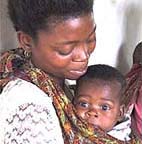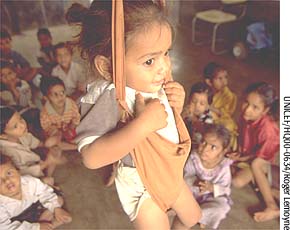|
||||

|
|
|||||
|
March 2002 Return to March 2002 contents page Reports from the sharp end 2: India: an environmentally sustainable solution in a crowded country
Immunizations account for only a fraction of the injections given in many health care facilities (see Immunization Focus, March 2001), but the overall healthcare waste management policy followed at this hospital is nevertheless of interest to immunization programme managers, since many immunization centres share disposal facilities at hospital or district level. Medical waste includes a broad range of components in addition to injection equipment, such as chemicals, radioactive wastes, used dressings, and large quantities of plastic. Instead of relying on just one method of disposal for all these items – autoclave, microwave, incinerator or hydroclave – Verma, a medical doctor and administrator, believes that a hospital needs to have all four to ensure waste is disposed of in the appropriate way. The key is to ensure that waste is properly segregated: the benefits outweigh the costs, says Verma, and hospital-related illness is reduced. Although incineration is widely regarded as the best method for disposing of injection equipment, Verma has shown that much plastic hospital waste can safely be disinfected with hypochlorite solution or microwave, then shredded and sold for recycling. He believes this is preferable to having poorly maintained and wrongly used incinerators, which are already common in urban India, and which may emit pollutants such as dioxins and furans. Burial of injection equipment, plastics and human or animal tissue are not options in urban areas, he says, given the sheer population density in India and the competition for scarce land. So the hospital in Bangalore, and the other Armed Forces hospitals, use a relatively sophisticated system that is suitable for their needs. After an injection is completed the used syringe is placed in a destroyer. A mechanical cutter cuts off the syringe at the nozzle. The needle is simply melted by passing an electric current through it. The resulting waste is disinfected and placed into an old water tank at underground level: the tank will take 5-10 years to fill, Verma estimates. The remainder of the plastic syringe is disinfected, shredded and the plastic is recycled. Waste handlers wear protective gloves, masks and goggles. Staff are trained not to recap needles or handle used syringes at all after use. For more information see www.medwasteind.org/verma.htm and www.expresshealthcaremgmt.com/20010930/editorial2.htm Phyllida Brown
Return to March 2002 contents page
|
|||||
| Contact GAVI | Guestbook | Text version | Credits and Copyright
|
|||||

 AIR
MARSHAL LK Verma, director general of medical services for the Indian
Air Force, has taken on many challenges in his career – and
medical waste disposal is just one of them. In a WHO pilot project
at the Command Hospital Air Force, Bangalore, Verma has developed
a "multi-option" approach that he believes is safe, appropriate
and environmentally sustainable. The pilot project, one of 11 in
India, was completed in 2000 and the approach is now being extended
to all Armed Forces hospitals around the country by mid-2002, supported
by the Indian Ministry of Defence.
AIR
MARSHAL LK Verma, director general of medical services for the Indian
Air Force, has taken on many challenges in his career – and
medical waste disposal is just one of them. In a WHO pilot project
at the Command Hospital Air Force, Bangalore, Verma has developed
a "multi-option" approach that he believes is safe, appropriate
and environmentally sustainable. The pilot project, one of 11 in
India, was completed in 2000 and the approach is now being extended
to all Armed Forces hospitals around the country by mid-2002, supported
by the Indian Ministry of Defence.